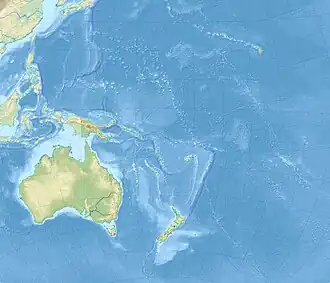2009 Vanuatu earthquakes
The 2009 Vanuatu earthquakes were three earthquakes with magnitudes ranging from 7.4 to 7.8, constituting some of the largest earthquakes in Vanuatu's history.
 | |
| UTC time | 2009-10-07 22:03:14 |
|---|---|
| 2009-10-07 22:18:51 | |
| 2009-10-07 23:13:48 | |
| USGS-ANSS | ComCat |
| ComCat | |
| ComCat | |
| Local date | October 8, 2009 |
| Local time | 09:03 |
| 09:18 | |
| 10:13 | |
| Magnitude | 7.7 Mw |
| 7.8 Mw | |
| 7.4 Mw | |
| Depth | 45.0 km (28 mi) |
| 35.0 km (22 mi) | |
| 31.1 km (19.3 mi) | |
| Epicenter | 12.517°S 166.382°E |
| Max. intensity | IX (Violent)[1] |
| Tsunami | 62 cm (2.03 ft)[2] |
| Aftershocks | Yes, strongest being Mw 7.4[3] |
| Casualties | None |
Tectonic Setting
The Vanuatu earthquakes of October 7, 2009: M 7.7, Vanuatu, 22:03:14; M 7.8 Santa Cruz Islands, 22:18:51 UTC; and M 7.4, Vanuatu, 23:13:48; all occurred as a result of shallow reverse faulting on or near the plate boundary interface between the Indo-Australian Plate and Pacific Plates. In the region of these earthquakes, the Indo-Australian plate moves to the east-northeast with respect to the Pacific plate at a velocity of about 91 mm/yr. The Indo-Australian plate thrusts under the Pacific plate at the New Hebrides Trench and dips to the east-northeast. The locations, depths, and focal mechanism solutions for the October 7th events are all consistent with them resulting from reverse faulting associated with subduction along the Australia-Pacific plate boundary.
The 7.8 Mw earthquake of October 7, 2009 (22:18 UTC), occurred about 60 km north, and 15 minutes after, a slightly smaller earthquake with a 7.7 Mw of the same date Occurred (22:03 UTC). A third, smaller event at 7.4 Mw occurred at 23:13 UTC, 15 km to the southeast of the first event. All three events are likely related; while the first two similarly sized events may be considered a doublet earthquake, preliminary analysis suggests that the 7.4 Mw earthquake is likely a large aftershock of one of the events.[3]
Earthquake
More than a dozen earthquakes above 5.0 magnitude shook the country within two days of the earthquake sequence,[4] The largest earthquake of the sequence, measuring a magnitude of 7.8, Mw struck the province of Torba, with an epicentre 294 km (183 mi) northwest of the island of Espiritu Santo,[5] and is the second largest earthquake of 2009. None of these tremors caused any casualties.[6]
Aftershocks and other events
About 15 minutes prior, a magnitude 7.7 earthquake struck the same area. Due to them occurring in the same region, both events are considered a doublet earthquake.[1] About an hour after that event, a magnitude 7.4 earthquake struck the same area, it is considered an aftershock to one of the events.[3] At least nine aftershocks of magnitude six or higher were recorded by the USGS.[7] Some of the aftershocks, as large as magnitude 6.1, were located in the Solomon Islands.[8] the largest earthquakes of the aftershock sequence were the aforementioned 7.4 event as well as a magnitude 6.8 tremor on October 8.[9] On June 3, 2009, an unrelated magnitude 6.3 earthquake struck 38 km west of the capital of Port-Vila, injuring four, damaging a few buildings and triggering landslides.[10]
Tsunami
A tsunami was observed all over the Pacific Ocean, with waves as high as 62 cm (2.03 ft) in Port-Vila, Vanuatu, 30 cm (0.98 ft) in Santa Monica, California, and 16 cm (0.52 ft) in Atka, Alaska.[2]
See also
References
- "M 7.7, Vanuatu". 7 October 2009.
- "M 7.8 - 196 km NW of Sola, Vanuatu". 7 October 2009.
- "M 7.4 - 143 km NW of Sola, Vanuatu". 7 October 2009.
- "Dozens of Tremors Rock Vanuatu". Earthquake Observatory. 9 October 2009.
- "3 Earthquakes Strike Vanuatu, No Casualties Reported". CBS News. 7 October 2009.
- "7.8 Magnitude earthquake Rocks Vanuatu". 7 October 2009.
- "lists, maps and statistics - 2009". 31 December 2009.
- "M 6.1 - 59 km S of Lata, Solomon Islands". 10 October 2009.
- "M 6.8 - 188 km NW of Sola, Vanuatu". 8 October 2009.
- "M 6.3 - 38 km W of Port-Vila, Vanuatu". 3 June 2009.